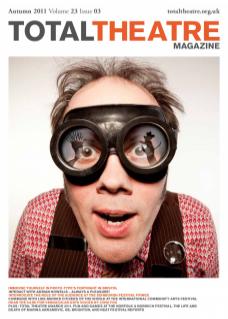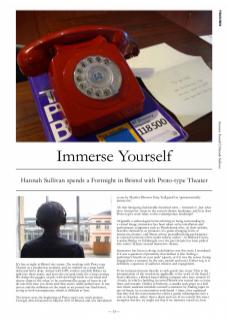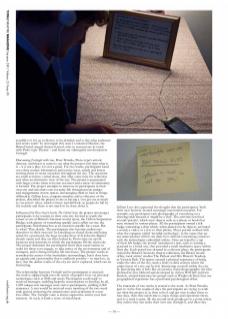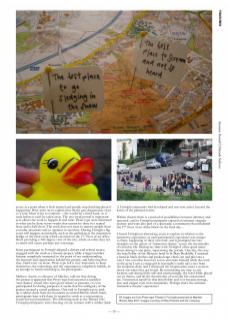It’s late at night in Bristol city centre. I’m working with Proto-type Theater as a production assistant, and we embark on a mass hand-delivered letter drop. Armed with GPS, torches and Jelly Babies we split into three teams, and leave the car park ready for a long evening. We dodge the gaggles of girls with their high heels in one hand and cheesy chips in the other, to be confronted by gangs of foxes in culde-sacs that stare you down and then scurry under parked cars. It was just us and the milkman on the roads as we posted our final letters, trying to look inconspicuous, which is difficult at 3am.
The letters were the beginning of Proto-type’s two-week project, Fortnight, which featured in Mayfest 2011 in Bristol, and was introduced to me by Mayfest Director Kate Yedigaroff as ‘quintessentially immersive’.
Ah that intriguing fashionable theatrical term – ‘immersive’. Just what does ‘immersive’ mean in the current theatre landscape, and how does Proto-type’s work relate to this contemporary landscape?
Originally a technological term referring to being surrounding by a virtual image, immersive has been taken on by installation and performance companies such as Punchdrunk who, on their website, describe themselves as ‘pioneers of a game-changing form of immersive theatre’, and Shunt, whose groundbreaking performance in unusual locations (often under railway arches – in Bethnal Green, London Bridge or Edinburgh) over the past decade has been pulled into critics’ debates around immersive theatre.
Immersive has been evolving in definition over this time: I wondered if it was a question of proximity that defines it (the ‘feeling a performer’s breath on your neck’ aspect), or if it was the senses (being dragged into a scenario by the ears, mouth and nose). Either way, it is definitely a question of audience relation and engagement.
To be immersed means literally to sink gently into water. This is the interpretation of the word more applicable to the work of the Stand + Stare collective, a Bristol-based sibling company who have created SS Arcadia, in which a building in central Bristol was turned into a cruise liner, and recently Children of Modernity, a smaller scale piece in a bell tent where audience members unravel a narrative by finding tapes in jars of beans. In a conversation with Stand + Stare, they explained that they feel the term immersive elicits a gentle submergence into a role or situation, rather than a dunk and run. If we extend this water metaphor further, we might ask that if we immerse ourselves, how possible is it for us to drown, to be deluded, and is this what audiences and artists want? To investigate this issue I contacted Mayfest, the Bristol based annual theatre festival, who in turn put me in touch with Proto-type Theater – and hence my subsequent involvement in Fortnight.
Discussing Fortnight with me, Peter Petralia, Proto-type’s artistic director, said that it is easier to say what the project isn’t than what it is – it is not a play; it is not a game. For two weeks, participants hand over their contact information and receive texts, emails and letters inviting them to secret occasions throughout the city. The occasions are small activities, visited alone, that offer some time for reflection and often an alternative view of the city. The project is punctuated with larger events when everyone can meet and a sense of community is formed. The project attempts to immerse its participants in their own city and into their own everyday life through poetic nudges and engagements in new spaces, encouraging them to look at things differently. Gillian Lees, company member and co-director of the project, described the project to me as having a ‘you get out as much as you put in’ ethos, which is brave and difficult, as people do fall by the wayside and there is not much to be done about it.
Influenced by Pico Iyer’s book The Global Soul, the project encourages participants to be tourists in their own city. Invited to watch the sunset at one of Bristol’s foremost tourist spots, the Clifton Suspension Bridge, with glasses of something sparkly and a cellist on site, the participants find themselves at an occasion suitable for a toast. But to what? They decide. The participants also become undercover detectives in their own city: by knocking on closed doors and being asked for a password, the huge wooden door of St John the Baptist church opens and they are then locked in. Proto-type set up the locations and situations in which the participants fill the main role. The project dislocates the participants from their usual routine in order for them to re-engage, to take notice of the environment and of strangers, and to bring everyday life into focus. The project works to reawaken the senses to the immediate surroundings, but it does have an agenda and a personality that is endlessly positive – so much so, in fact, that the darker truths of the city are never explored, which can be frustrating.
The relationship between Fortnight and its participants is unusual; the work is slipped right into the centre of people’s lives via personal technologies such as SMS and email. Participants could reply to received messages, enabling bespoke conversations to develop. In all, 1,089 unique text messages were sent to participants, yielding 2,000 responses. A text would be received every morning of the two-week time period, mirroring the attentiveness and excitement of a new love affair. The Fortnight voice is always supportive and in your best interests. As such, it lends a sense of attachment.
Gillian Lees also expressed the thought that the participants ‘built their own hysteria’ around seemingly uneventful occasions. For example, one participant took photographs of everything on a dressing table because it ‘might be a clue’. The activities revolved around ‘portals’, which were objects such as a phone or book that were situated in various places. All the participants owned a felt badge containing a chip which, when placed on the objects, activated a sound, a video, or a text to their phone. These portals worked with what the company called ‘invisible technology’, in the sense that we use smart phones within our daily lives without concerning ourselves with the technologies embedded within. Once activated by a tap of their felt badge, the ‘portal’ introduced a task, such as writing a postcard to a loved one, that provided a small meditative space within their day. Each portal was situated in a relevant place; the participants visited the Bristol University theatre collection, the Bristol record office, local artists’ studios The Parlour and Mrs Brown’s Teashop in Victoria Park. The spaces created a physical experience of being under the skin of the city, sunk a little, in dark corners where the under-layers of a city can be felt. Immersing yourself within the city by burrowing into it feels like an exercise in psychogeography: the idea (defined by Guy Debord and developed by writers Will Self and Iain Sinclair, and performance/art groups such as Wrights & Sites) that our geographical experience has a profound psychological effect.
The timescale of two weeks is crucial to the work. As Peter Petralia puts it: in the first couple of days the participants are trying to work out what the project is, to then solve it and get over it takes three to four days, then they need time to enjoy things and experience them, and so a week is gone. By the second week people get to a point where they realise they can make their own way through it, and then they arrive at a point when it feels normal and people stop thinking about it happening. Peter went on to explain that then it gets dangerously close to a time when it has to continue – this would be a third week, so it ends before it can’t be taken away. The two-week period is important as it allows the work to happen in real time: Proto-type were interested in what can be done in two weeks that cannot be done in a typical hour-and-a-half show. The work does not want to remove people from everyday situations and so operates in real time. During Fortnight a big event will happen occasionally, such as the gathering at the suspension bridge or the final event which occurred on the 17th floor of an office block providing a 360-degree view of the city; while on other days not so much will occur, perhaps just a message.
Some participants in Fortnight adopted a distant and critical stance, engaged with the work as a theatre project, while a larger number became completely immersed to the point of not understanding the legwork and organisation behind the project, and believing that they could carry on alone. Proto-type felt it very important to keep themselves, the technology and the organisation completely hidden, in an attempt to hand ownership to the participants.
Mathew Austin, co-director of Mayfest, told me that during the project it appeared that Proto-type had accessed a nameless ‘non theatre’ crowd who were given tickets as presents, or even participated for dating purposes: it seems that the ambiguity of the project created a varied audience. One task in Fortnight was to pick up a rubber duck from the fountains in central Bristol, which many participants kept with them (it seemed to work as a conversation starter between members). The following week at the ‘Bristol 10k’, Fortnight participants were cheering on any runners with a rubber duck. A Fortnight community had developed and was now active beyond the limits of the planned events.
Within theatre there is a myriad of possibilities between intimacy and spectacle, and in Fortnight participants enjoyed an intimate singular journey and were also part of a spectacle; a community that inhabited the 17th floor of an office block on the final day…
I found Fortnight an interesting event to explore in relation to the immersive experience, as each participant’s experience was unique to them, happening in their own time, and it prompted me into thoughts on the nature of ‘immersive theatre’ versus the theatricality of everyday life. During my time with Fortnight I often spent many hours sitting in one place, supervising the portals. One day, this was the hotel lobby of the Mercure hotel in St Mary Redcliffe. I watched a band in black clothes and peaked caps check out and pile into a van; I saw a mother leave her son to entertain himself while she went to the gym; I saw a young girl in last night’s outfit call a taxi from the reception desk; and I witnessed the receptionists enact a western shoot-out when they got bored. By committing my time to one location and sitting fairly still and unassumingly, the hotel lobby played out its drama, and all the theatricality of everyday life entertained me. I immersed myself in that hotel lobby and so it became strange, fun, and unique even in its mundanity. Perhaps that’s the ultimate ‘immersive theatre’ experience?



